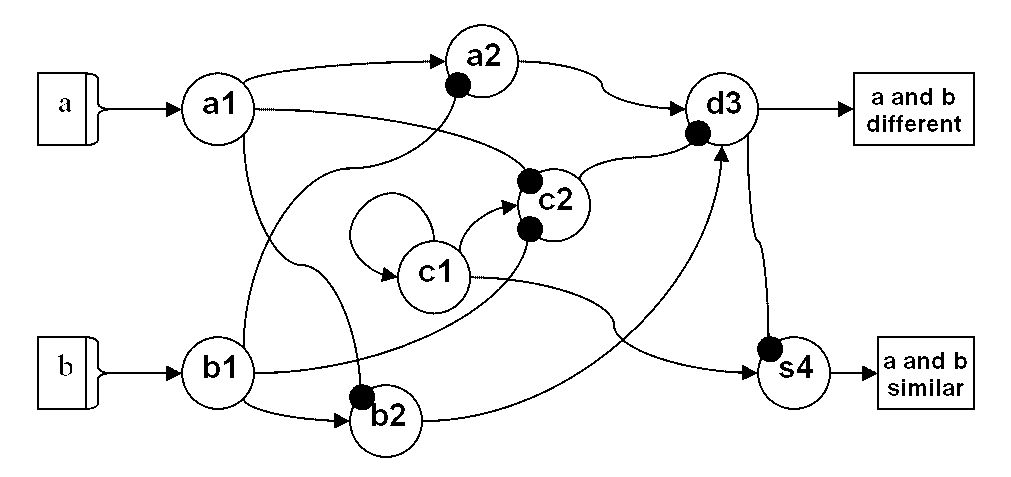
The fact of the matter is that we have nervous systems that abstract from the WIGO. Each abstraction is a map that is not the territory it abstracted from. When we are conscious of our abstractions we evaluate, judge, etc., a primitive kind of "sameness" based on the fact that built in nervous circuits that process multiple inputs do not activate.
Consider two neuron paths involving 8 cells going from inputs a1 and b1 to outputs d3 and s4.

a2, b2, and c2 are the next level of abstraction.
They are connected as follows.
Here's a table showing the relations. Look at a2, b2, and c2, to see the results of the above criteria. (More discussion - of the other columns - follows the table.)
The first two columns represent the inputs.
input abstractions a1 b1 a2 b2 c2 d3 s4 output only one input active on off on off off on off a and b
differentoff on off on off on off both inputs active on on off off off off on a and b
similarneither inputs active off off off off on off on
Now let's look at the third level of abstraction.
Look at the d3 column.
Notice that d3 is only
on when either a1 or a2 is on but not both, so d3 turns on when the inputs a1 and
a2 are different in terms of activation.
Now add level of abstraction 4.
Look at the s4 column.
Notice that s4 is only on when both a1 and a2 are off
or a1 and a2 are on but not both.
S4 turns on when the inputs a1 and a2 are the same in terms of activation.
So the D3 output is a "difference detector", and the S4 output is a "similarity detector". Note that this does not refer to what is different or similar in the WIGO; it refers to what is different or similar at the first level of abstraction, and that is simply whether or not (a binary - two valued state) the two input cells are active or inactive together or separately.
Our brains have millions of such circuits. (See the books I have recommended).
Those little circuits can be connected to any two inputs whether from sensory inputs or from memory or one from each. The outputs can be connected to more such circuits. This is how we get hierarchical determination of sameness by breaking things down into parts. The capability is built into the brain and our nervous system, and it is so built in at very low orders in the phylogenetic scale. Even very primitive organisms have such simple comparator circuits.
The key to remember is that there is abstraction from the WIGO to the very first a1 and b1 sensory inputs. There is abstraction from memory to the very first a1 and b1 inputs.
We know (based on the above knowledge) that we cannot know about the WIGO our abstractions are in response to. We only know that our neurological comparator circuits signal that abstractions match or that abstractions do not match - not that which the abstractions are from.
Just how conscious are you of your abstraction process? Do you bring to bear all the knowledge that is available about how the nervous system works?
Korzybski's definition of identical as "the same in every respect" is a pure Aristotelian definition. It cannot be empirically tested. It can only be used and "tested" in the logical and mathematical semantic space, not in any physical "reality".
Here's my taxonomy
An exposition of what this means in Korzybski's perspective is here: Knowledge a la Korzybski.
How do you "know" when two things are "identical"? You cannot "know" in any "strong" sense of the term. The best you can do is fail to discover differences in your abstractions from them. You can have a "theory" that two things are "the same" (whatever that means), but you cannot do any better than fail to discover differences, and that failure is as much a part of your (our) own construction as it is of anything else.
Try to remember that "meaning is in the person", and words or formulations are chosen to encode and represent those meanings; because "the word is not the thing" different words can be chosen to represent the meanings. It takes a process of continuous feedback to get close to understanding each other.
See Talk - a graphic presented at the New York Society for General Semantics.
Just because I may choose a different word that you think appropriate, does not mean that I'm talking about something totally different. Read and integrate the entire discussion. I understand that you hear my words with your meanings. My feedback is to try to provide enough additional information that you can get closer to my meanings (and I yours).
| This page was updated by Ralph Kenyon on 2013/03/20 at 10:28 and has been accessed 10466 times at 48 hits per month. |
|---|